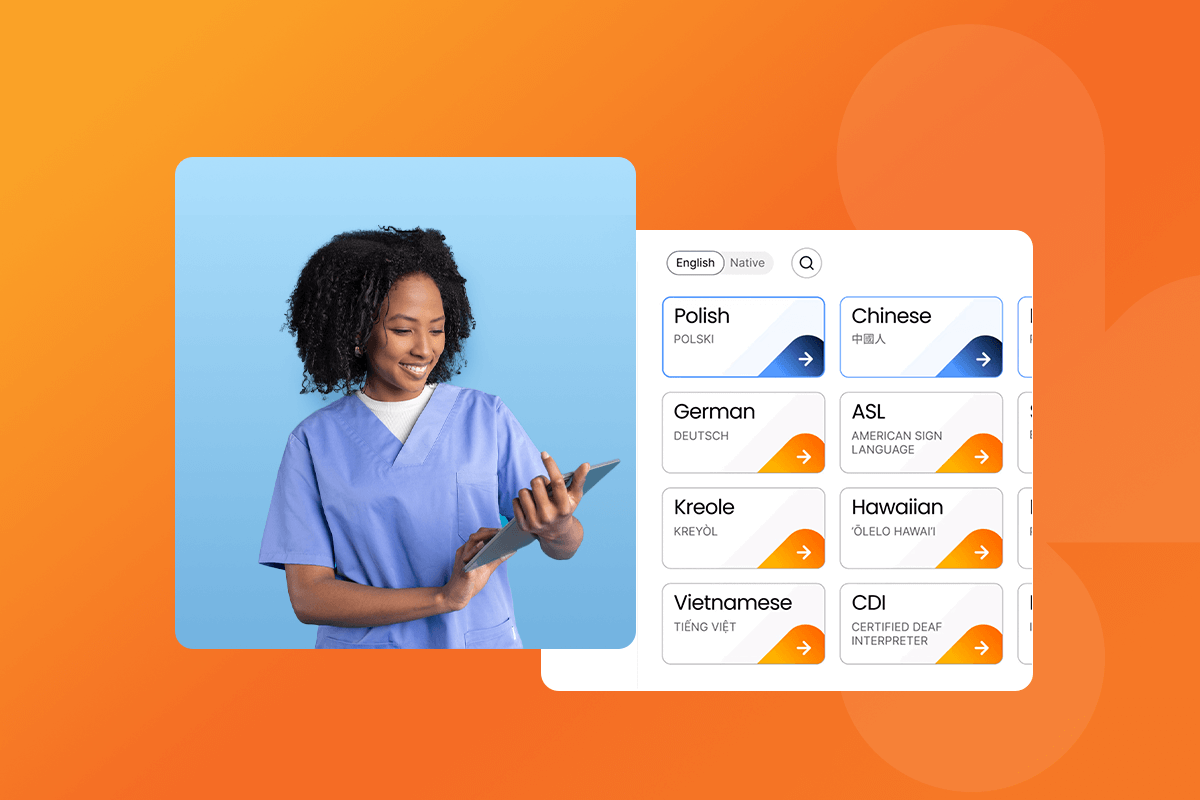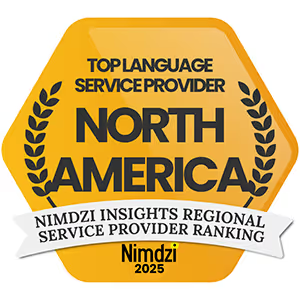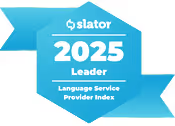Section 1557 of the Affordable Care Act (ACA) is a critical regulation that impacts healthcare facilities across the United States. It ensures all patients have equal access to healthcare services. Understanding this law is essential for healthcare administrators, financial teams, IT teams, and legal departments to avoid compliance risks and ensure high-quality patient care.
One of the stipulations of Section 1557 ensures all patients have equal access to healthcare services, which means providing services in each patient's preferred language. Video remote interpretation (VRI) and over-the-phone interpreting (OPI) play important roles in meeting these requirements. These technologies provide real-time access to qualified medical interpreters, helping facilities comply while improving patient experiences.
What Is Section 1557?
ACA Section 1557 is the nondiscrimination provision that prohibits discrimination based on color, race, national origin, sex, age, or disability in healthcare programs and activities that receive federal funding in the U.S. One of the most significant aspects of this law is the requirement to provide meaningful access to services to individuals with limited English proficiency (LEP) and patients with disabilities.
Healthcare organizations must offer language access services, which include qualified interpreters, translators, and bilingual staff, to ensure effective communication for all patients and healthcare providers. These organizations include hospitals, clinics, nursing homes, pharmacies, telehealth service providers, and any facility that accepts Medicare, Medicaid, or other federal funds.
Section 1557 ACA Requirements
ACA Section 1557 includes rules for disability concerns, language assistance, and more.
- Language assistance: Healthcare facilities must provide language assistance services at no cost to their patients to ensure effective communication for LEP and Deaf or hard of hearing patients or patients who have speech disabilities. Language assistance may be provided through qualified interpreters, qualified translators, and qualified bilingual staff, among other services.
- Auxiliary aids and services: Healthcare facilities must provide auxiliary aids and services, which are devices or services that enable effective communication with individuals with disabilities. These may include remote and on-site interpreting services, written materials in large print or Braille, screen readers and magnification tools, and audio recordings.
- Qualified interpreters: Facilities must provide qualified interpreters to relay important information instead of relying on family members or untrained staff.
- Patient rights: Healthcare facilities must post notices in their most common languages, informing patients of their rights to language access services through notices in multiple languages.
What Do Healthcare Facilities Need for Section1557 Compliance?
Complying with Section 1557 involves several steps, including creating a language access plan, updating policies, training staff, providing language access services, and improving IT infrastructure. Interpreters must be qualified and updated on current medical terminology, which is why facilities cannot rely on family members or untrained staff for interpretation. Facilities must also ensure effective communication, which may require auxiliary aids, screen readers, and accessible electronic health records (EHR).
What Are the Consequences of Violations of ACA Section 1557?
Failing to comply with Section 1557 can lead to serious financial, legal, and reputational consequences.
- Civil rights complaints: Patients who believe their rights were violated can file complaints with the Office for Civil Rights (OCR) at the Department of Health and Human Services (HHS). OCR investigates these claims and can take enforcement actions.
- Financial penalties: Noncompliance can lead to lawsuits, costly settlements, loss of federal funding, or fines and penalties imposed by HHS.
- Reputational damage: Legal actions and complaints can harm a facility's reputation, leading to negative media attention, loss of patient trust, and potential loss of accreditation from regulatory bodies.
- Increased operational costs: If a facility is found to be noncompliant, it may need to implement costly corrective action plans, hire additional staff to manage compliance issues, and upgrade IT systems to improve accessibility.
Key Deadlines and Timelines
While Section 1557 has been in place since 2016, updates and enforcement policies continue to evolve. The section has also undergone certain legal challenges since its implementation.
It is important to regularly check for changes to language access requirements, accessibility standards for digital health platforms, and documentation or reporting expectations. Facilities must also post updated nondiscrimination notices within 60 days of policy changes and regularly review and update policies to reflect new compliance guidelines.
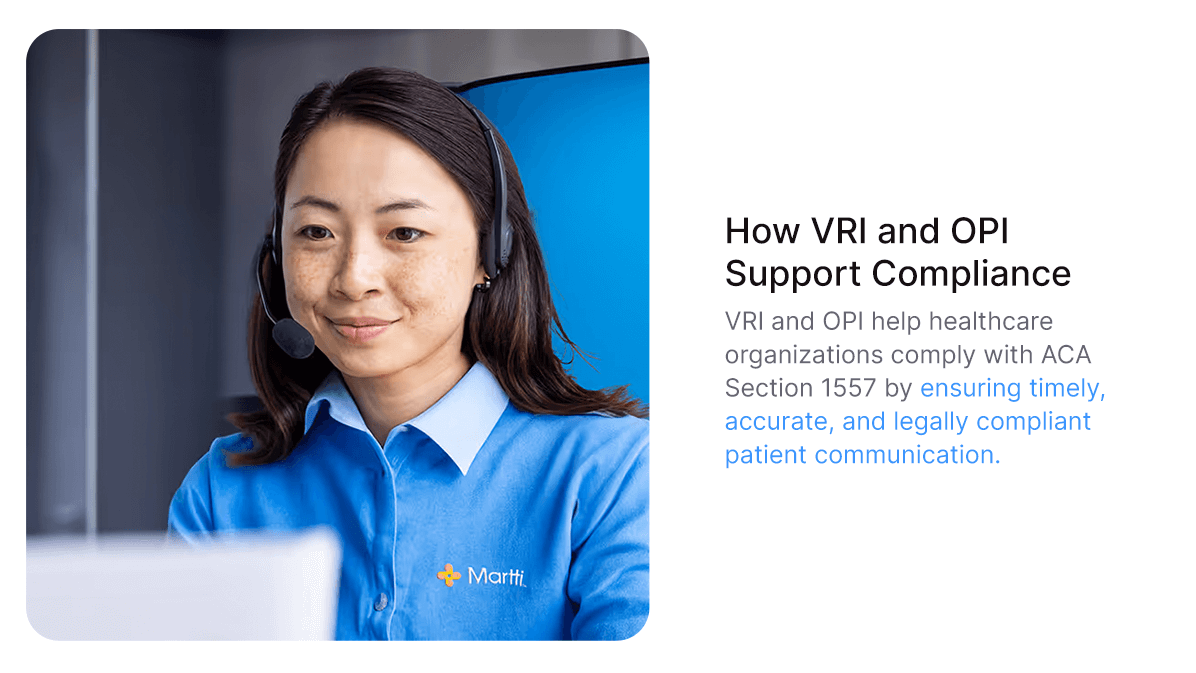
How VRI and OPI Support Compliance
VRI and OPI provide on-demand access to professional medical interpreters, reducing wait times and ensuring accurate language support. They help healthcare organizations care for their patients and comply with ACA Section 1557 by ensuring timely, accurate, and legally compliant patient communication.
VRI connects providers with interpreters through a secure video platform. This is a cost-effective addition to on-site interpreters that still offer face-to-face interaction. It is especially useful in situations where visual communication is important, such as:
- Emergency care, where quick decision-making is critical.
- American Sign Language (ASL) interpretation for Deaf and hard-of-hearing patients.
- Complex medical discussions that require visual cues.
OPI provides interpreters with phone access. It is often more affordable than on-site and video interpretation and can be used with a phone connection in any location. These factors make it ideal for:
- Quick conversations, like appointment scheduling.
- Situations where video access is unavailable.
- Facilities that serve an even more diverse population and need interpretation in languages that are more difficult to find in the U.S.
Implementing Language Access Solutions inHealthcare Facilities
Every healthcare facility has different language access needs. Review patient demographics, common languages used, and existing interpretation services to help you determine the best combination of VRI, OPI, and on-site interpreting for your facility. With that knowledge in mind, you can choose compliant language service providers. Look for providers that offer medically trained and certified interpreters, HIPAA-compliant technology, and support for a wide range of languages, including ASL.
Training and Monitoring Usage
Even the best language technology is ineffective if staff do not know how to use it. Training should include:
- How to access interpreters quickly.
- When to use VRI versus OPI versus on-site interpreting.
- Best practices for ensuring patient comfort and understanding in effective communication.
Regular health audits and staff or patient feedback can help identify gaps in language access services. Facilities should track interpreter usage, patient satisfaction, training compliance, and any communication challenges that arise.
Why Trust Us
Martti offers round-the-clock access to EHR-integrated interpretation. Our software uses predictive analytics, transaction reports, and live usage data to give administrators valuable insight into their language services, supporting Section 1557 compliance. Our interpreters have over 120 hours of specialized training in addition to ongoing continuous education and are qualified in medical interpretation to deliver reliable services.
We protect sensitive data with HIPAA compliance and provide robust encryption with 99.99% uptime for reliability. Our service includes group calling, document translation, and other related tools. Find out how our technology has helped various medical institutions remain compliant.
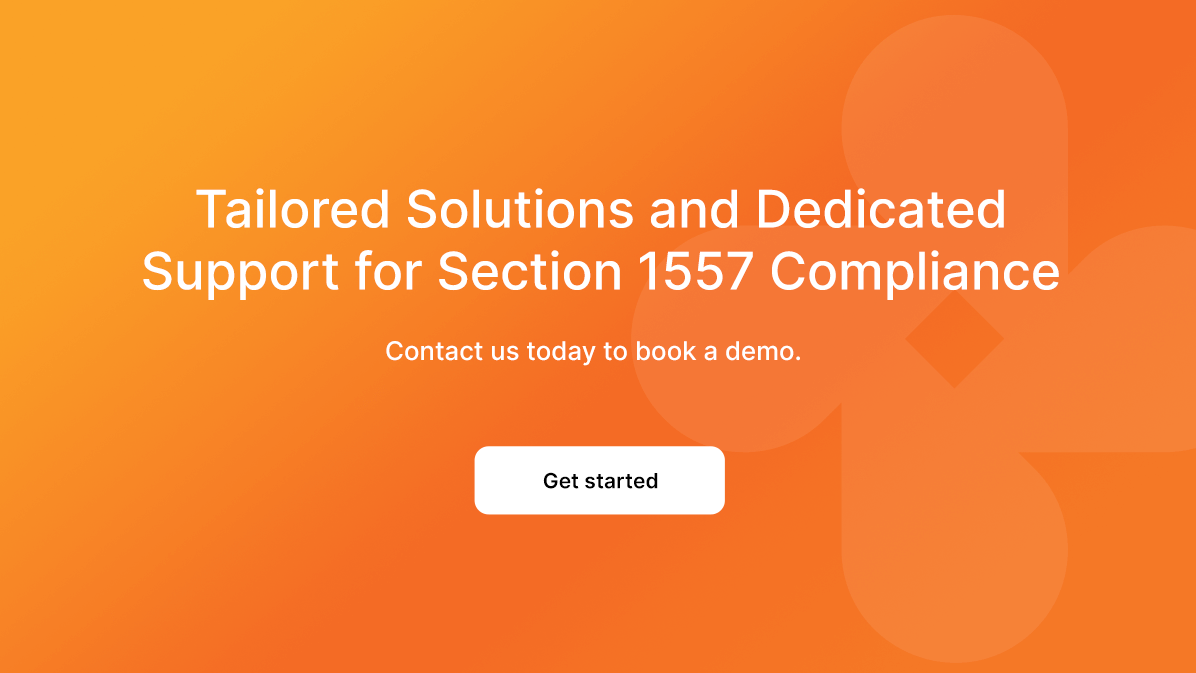
Tailored Solutions and Dedicated Support for Section 1557 Compliance
ACA Section 1557 rules for disability concerns are more than a legal requirement. They are a fundamental part of delivering quality healthcare. VRI and OPI are practical, cost-effective solutions for meeting language access requirements. By implementing these services, healthcare facilities can enhance communication, protect patient rights, and reduce the risks associated with noncompliance.
Martti gives you access to real-time medical interpretation in over 250 languages at any time, day or night. You can connect through a user-friendly app within 20 seconds on average and access medical interpreters who can sensitively convey cultural nuance and complex medical terms.
Contact us today to book a demo.
Linked Sources:
- https://www.hhs.gov/civil-rights/for-individuals/section-1557/fs-sex-discrimination/index.html
- https://www.kff.org/affordable-care-act/issue-brief/the-biden-administrations-final-rule-on-section-1557-non-discrimination-regulations-under-the-aca/
- https://oneill.law.georgetown.edu/legal-challenges-against-acas-section-1557-anti-discrimination-protections/
- https://www.hipaajournal.com/the-use-of-technology-and-hipaa-compliance/
- https://www.martti.io/technology
- https://www.martti.io/case-studies
- https://www.martti.io/contact


